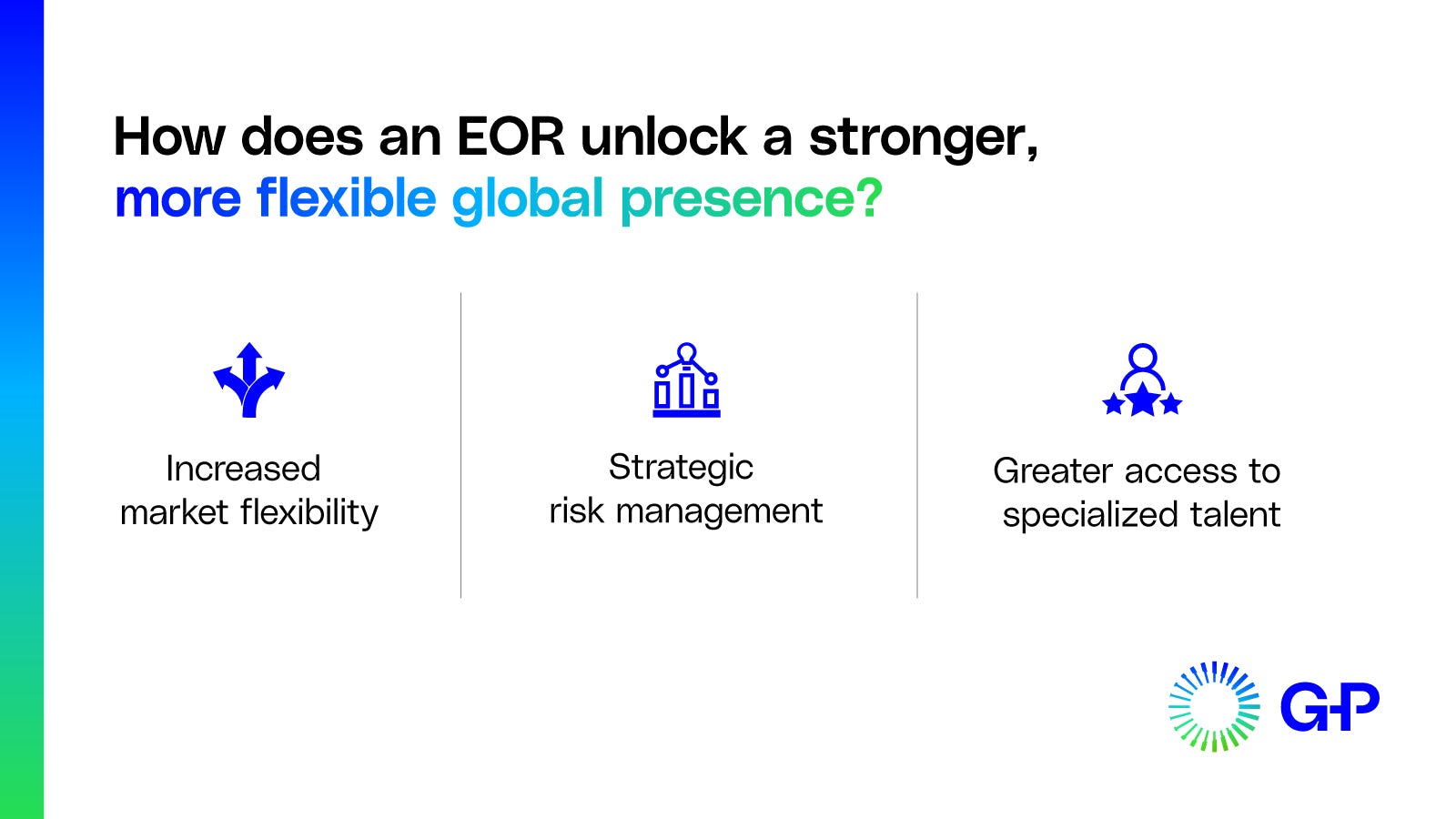As we discussed in part one of our “EOR vs. Global Entity” series, operating across multiple countries is a constant juggling act. With ever-changing labor laws and strict regulatory environments, the traditional approach of setting up an entity can often trigger compliance issues. This can cause significant fines or penalties, potentially damaging your brand reputation in global markets.
Faced with these obstacles, companies are exploring options to reduce the burden of setting up and maintaining their global entities — and finding that the global Employer of Record (EOR) model offers more agile and cost-effective solutions. Companies can retain talent, optimize global operations, and gain a new level of market flexibility by partnering with an EOR. What’s more, the EOR takes on compliance and risk management, freeing companies to focus exclusively on business growth. And for companies looking to make the transition to an EOR, G-P offers advisory services that streamline the process and mitigate risk.
In this second installment of our three-part series, we will examine why some companies decide to wind down their global entity, the advantages of switching to an EOR-based model, and important considerations before transitioning to an EOR.
What motivates a company to wind down a global entity?
Winding down a global entity is not a step backward.
Winding down a global entity is not a step backward. By making this decision, a company is pivoting operations to ensure long-term success. There are several reasons why a company might decide to wind down their global entity, including:
- Shifting key market strategies: When companies change their overall strategy, they must actively redirect energy and resources to different areas. Consequently, companies might need to prioritize investments in more promising regions. This could result in consolidating operations and winding down global entities in less critical markets.
- Protection against market fluctuations: Market changes considerably influence a company’s revenue. Political instability and geopolitical factors can create uncertainty and risk. Additionally, complying with new regional or country-specific regulations can be time-consuming and impact profits, making it hard to justify maintaining a global entity in certain regions.
- Downsizing to realign resources: Following an acquisition, the buying company may decide to downsize to redirect resources strategically. In this scenario, leveraging an EOR can help retain key talent while reducing high-cost entity expenses like on-the-ground HR specialists and legal consultants. By doing this, companies will also be better positioned to re-enter the market later if conditions change.
How does an EOR unlock a stronger, more flexible global presence?
Winding down a global entity isn’t surrendering your market presence. Instead, companies can switch to an EOR to retain talent and solidify market presence while avoiding the annual costs of maintaining an entity. Other benefits include:

- Increased market flexibility: Establishing and maintaining a global entity can actively limit a company’s expansion abilities. The process is time-consuming and expensive, which can stop companies from growing into more countries. Partnering with an EOR, on the other hand, provides the flexibility to hire in any market within hours, ensuring speed to market and agility.
- Strategic risk management: Being tethered to a single market can hurt a company’s ability to diversify risk. When a company has a presence in multiple markets worldwide, it reduces its dependence on a single economy to succeed. Maintaining a flexible global presence through an EOR can mitigate different economic fluctuations across countries, preserving stability.
- Greater access to specialized talent: As companies worldwide increasingly adopt the EOR model, numerous countries and regions are transforming their locations into talent hubs. An EOR provider like G-P has the knowledge to steer companies toward these untapped talent pools that may otherwise go unnoticed.
What are 3 key factors to consider when switching from a global entity to an EOR?
Detailed planning and execution is required when transitioning from a global entity to an EOR. To ensure a successful transition, it is essential to seek the expertise of an industry-leading EOR provider. Key factors to consider before making the switch include:
Choosing the right partner carefully: “Having an EOR that cares about your workforce makes a difference,” Kathryn Barnes, Senior Legal Counsel at G-P said, “as this translates into your employees continuing their faith in you, which ultimately means continuing their employment with you, ensuring you still have a workforce tomorrow.” The first crucial decision for companies is selecting an EOR that will treat team members with care and empathy. Companies should make sure that the EOR can handle the number of retained professionals and facilitate a smooth transition.
Asking the right questions: Before finalizing an agreement with an EOR, conducting due diligence is important, mainly by asking targeted questions regarding the level of team member guidance and support provided, such as:
- Does the EOR have HR and legal teams with local expertise to guide professionals and ensure compliant operations?
- How can the EOR assure that team members will be compliantly classified?
- How can the EOR guarantee timely and accurate salary payments, and what other aspects of compensation will professionals receive?
Obtaining team member consent: In several countries, laws require your team members’ consent before a transfer to an EOR can take place. Companies risk losing valuable talent if the EOR partner is not equipped to deal with key aspects of team management, such as employment contracts, benefits, and seamless payroll transactions.
Once successfully transitioned to an EOR, companies will gain the flexibility to enter and exit markets with ease, which can be very beneficial in times of uncertainty or crisis. Unlike the initial burden of an entity wind down, EORs ensure that future downsizing and switching hiring markets can be done quickly and effortlessly.
Ensure a smooth transition with G-P.
Unlock the transformative benefits of transitioning from a global entity to an EOR by partnering with G-P today. With G-P as your global EOR, companies can streamline global operations, retain key talent, and gain the flexibility to navigate market changes quickly.
Through our growing range of G-P advisory services, we provide the guidance you need at every stage with a single touch point for information related to global entity transition and access to our HR and legal experts. We’ll take care of the hard part, so you can focus on the best part — growing your business globally.
Contact us today to learn how G-P advisory services can help your company make the change.
Stay tuned for the third and final part of our “EOR vs. Global Entities” series coming later this month, where we’ll be tackling how, when, and why to set up an entity.





